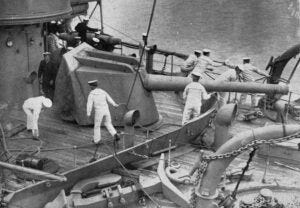Fullbore Friday
war is ready for you even when you are not ready for it
A battle that wasn't, and a warship that did not find her way to war - but a lesson none-the-less. I present to you HMCS Rainbow, the one of the first two ships of the Canadian Navy.
Her story reminds me of those who think that because their ship is not manned, armed, trained, or designed for a mission - that for some reason in war they will be given a pass. "They won't deploy a CVN that close to shore....we won't go without air superiority...there is no threat there...other units can do that...the 1,000 ship Navy concept addresses that..." and so on.
No, when the call comes - you get underway - as the crew of the RAINBOW did.
At 8:55 p.m. on the 4th of August, 1914, a telegram was received from Westminster announcing that war had been declared against Germany. ... HMCS RAINBOW was already at sea, and was therefore the first ship of the RCN to be at sea as a belligerent.
Rainbow’s fearless captain, Commander Walter Hose, understood the crucial importance of setting the right tone early on. Much, therefore, hung in the balance when Rainbow headed south in search of von Spee’s cruisers on Aug. 4, 1914. The German Asiatic Squadron represented a formidable challenge: Two modern armoured cruisers, Gneisenau and Scharnhorst, and four modern light cruisers, Dresden, Emden, Leipzig and Nurnberg. The two big ships carried 8.2-inch and 6-inch guns, and their gunnery was renowned as the best in the German fleet. Their armour was impenetrable to Rainbow’s guns at anything beyond point-blank range. Scharnhorst and Gneisenau were also faster, by nearly four knots (23 versus 19.75): They could eat Rainbow for breakfast. The light cruisers were more of a match, but the German ships were newer and four knots faster, too, while their modern 4.1-inch guns had a longer range than Rainbow’s aging 6-inch. In fair weather, any one of them could stand off and beat Rainbow into submission without being hit. By late July 1914, this powerful German force was largely dispersed, with Leipzig and Nurnberg exchanging places off Mexico as part of an international force protecting foreign interests during the Mexican civil war. The British had few ships in the Pacific, and these were scattered across a quarter of the earth’s surface. The great uncertainty facing von Spee was the intent of Britain’s Pacific ally Japan. Her powerful fleet made the western Pacific untenable, while the heavy cruiser Idzumo was with the international fleet off Mexico and had to be watched carefully. Also off Mexico were two aging British sloops, Algerine and Shearwater, each of about 1,000 tons and utterly defenceless. The only British warship in the whole eastern basin of the Pacific Ocean was little Rainbow. Rainbow was ordered to prepare herself for war, while a group of British Columbia businessmen opened negotiations with a Seattle shipyard for the purchase of two submarines being built for Chile. Hose soon had Rainbow ready for sea, but high explosive shells for her guns were not expected to arrive from Halifax until Aug. 6 because the railway refused to handle the explosives. So Hose drew antiquated shells filled with black powder (modern shells used cordite) from old stores in Esquimalt, filled out his crew from local volunteer “reservists” (an amateur group of naval enthusiasts who had no official standing) and declared his ship ready. On the afternoon of Aug. 2, the British requested that “Rainbow should proceed south at once in order to get in touch with (Leipzig) and generally guard the trade routes north of the equator.” This was an ambitious order for a partially manned training cruiser equipped with little more than solid shot. At 1 a.m. on Aug. 4, Rainbow cleared Esquimalt harbour. Few thought they would see her again.
Great story. Admiral Graf von Spee's squadron's saga ... well .... that is for a few FbF for later on.




Playing the run what you brung game in the first few days of a war is not the place you want to be on either the Rainbow or an LCS.
Not mentioned in the American Legion maganzine article but noted in this one, radio and fuel issues. Unless you're nuclear, a ship at sea better be certain of its fuel train.
https://hallmarkheritagesociety.ca/archives/history-articles/the-career-of-h-m-c-s-rainbow/
"Her wireless set had a maximum night range of only 200 miles, though this defect her wireless operators were able to overcome at a later date. An almost incredible fact is that she had no high-explosive ammunition; all she had been able to obtain was old-fashioned shell filled with gunpowder.[23] She had no collier and no dependable coaling-station south of Esquimalt (Vancouver Island). "